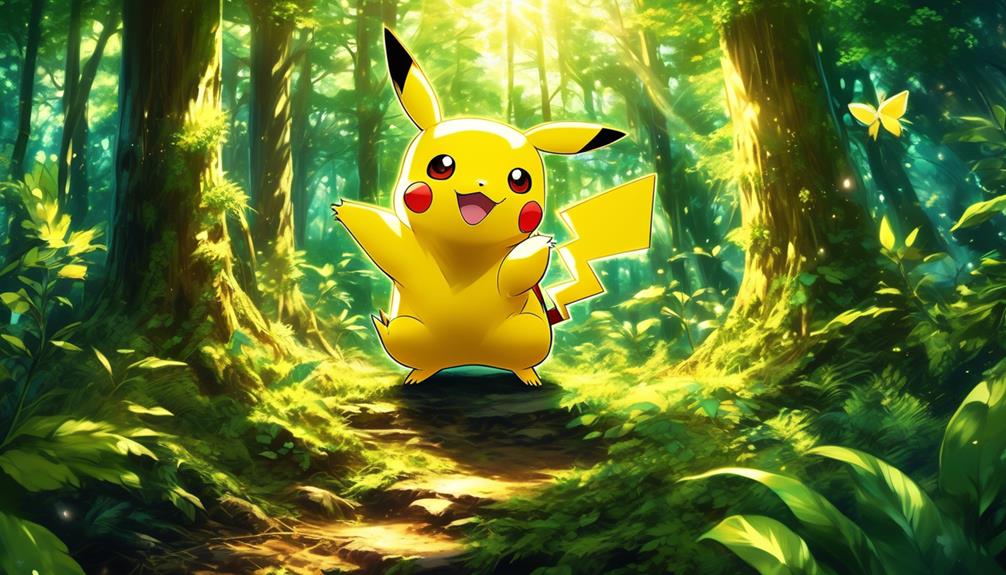You're wondering how many Pokémon there are? Well, you currently have access to a vast collection of 1017 officially registered Pokémon species, with unique characteristics, types, and forms that continue to evolve and expand with new game releases and updates. From regional variants to Mega Evolutions, each addition adds to the ever-growing list. As you explore the world of Pokémon, you'll discover more about the diverse range of species, Legendary and Mythical Pokémon, and the many forms that bring new challenges and strategies to the game – and there's still more to uncover.
Pokémon Generations Overview
As you explore the vast world of Pokémon, you'll discover that the franchise is divided into nine distinct generations, each with its unique set of Pokémon, regions, and gameplay mechanics that have evolved over time.
Each new generation brings exciting additions to the Pokémon universe, expanding the possibilities for adventure and exploration. From the original 151 Pokémon in Generation I to the latest additions, each generation has its own unique charm and attractions.
As you journey through the generations, you'll encounter new regions, each with its own distinct character and challenges. From the Kanto region of Generation I to the latest regions, each one offers a fresh start and new opportunities to catch 'em all!
With each new generation, the Pokémon franchise continues to evolve, introducing new gameplay mechanics, features, and Pokémon to capture and train. Whether you're a seasoned Pokémon Master or just starting your journey, each generation offers a unique experience that's sure to delight.
Counting Pokémon Species
As you explore the vast world of Pokémon, you'll notice that each species can be categorized into types and classes, influencing their strengths and weaknesses.
You'll also discover that many Pokémon undergo evolution stages, transforming into more powerful forms.
Additionally, regional Pokémon distribution plays a significant role in shaping the diverse range of species across different games and generations.
Pokémon Types and Classes
When you explore the world of Pokémon, you'll discover that each species belongs to a specific type, which greatly influences its strengths and weaknesses in battles. There are 18 different types of Pokémon, ranging from Bug to Dark to Water, and each type has its unique characteristics. Understanding these types is essential for strategic gameplay, as type matchups play a significant role in battles. For instance, a Fire-type Pokémon is weak against Water-type attacks, while a Grass-type Pokémon is resistant to Water-type moves.
As you dig deeper into the world of Pokémon, you'll notice that each species belongs to one or two types, which determines its strengths and weaknesses. The types of Pokémon have remained consistent since Generation 1, with the addition of new types like Fairy in Generation 6. With 1017 officially registered Pokémon species, mastering the art of type matchups is vital to becoming a skilled trainer.
Pokémon Evolution Stages
You'll explore various evolution stages as you investigate the vast array of Pokémon species, which greatly impacts the total count of unique Pokémon.
Each Pokémon can have multiple evolution stages, and some even have different forms, such as Mega Evolutions and Gigantamax forms. These variations contribute to the overall count of Pokémon species. For instance, including Mega Evolutions and Gigantamax forms brings the total count to 980 unique Pokémon.
Regional variants, like Alolan, Galarian, Hisuian, and Paldean forms, also add to the diversity of Pokémon species. These regional variants showcase the complexity and variety within the Pokémon world.
Additionally, gender differences further increase the total number of Pokémon, reaching 1261 species. As you explore further into the world of Pokémon, you'll discover that each species has its unique characteristics, making the Pokémon universe incredibly rich and diverse.
The various evolution stages, different forms, and regional variants all come together to create a vast and fascinating world of Pokémon.
Regional Pokémon Distribution
Exploring the world of Pokémon, you'll realize that regional forms, like Alolan Vulpix, are considered separate entries, adding to the total count. This means that even though you might've seen a Pokémon before, its regional variant will be counted as a distinct species.
The total count of 1017 spans across multiple games and generations, showcasing the diversity of Pokémon. What's more, each Pokémon, including regular and Legendary ones, contributes to the overall count on the Pokédex.
This highlights the complexity and richness of the Pokémon universe, where even the most subtle variations can make a significant difference. As new Pokémon are continuously added, you can expect the total count to keep growing, making the world of Pokémon even more fascinating and dynamic.
Regional Variants and Forms

As you explore the world of Pokémon, you'll discover that the franchise introduces unique twists on familiar favorites through regional variants and forms. These variations bring new excitement to classic Pokémon, offering fresh typings, designs, and abilities.
Alolan, Galarian, Hisuian, and Paldean variants, for instance, introduce significant changes to existing species. Take Alolan Ninetales and Galarian Zapdos, which boast new typings and designs that set them apart from their originals.
The latest addition, Scarlet & Violet, even introduced Paldean variants for Wooper and Tauros. Including all these regional variants brings the total number of Pokémon to 1075.
What's more, the number of Pokémon increases with additional breeds and forms, such as Zen Mode for Galarian Darmanitan. These forms of Pokémon expand the Pokémon universe, offering you more possibilities to explore and collect.
As you investigate further, you'll find that regional variants and forms add a rich layer of diversity to the Pokémon world, making it even more enthralling and immersive.
Mega Evolutions and Beyond
Beyond regional variants and forms, Mega Evolutions and other unique transformations further expand the Pokémon universe, offering powerful new possibilities for your favorite Pokémon.
You'll explore 46 Mega Evolutions across the Pokémon games, each providing stat boosts and new Abilities for specific Pokémon. But that's not all – there's also Battle-Bond Greninja, a special form that enhances the original Greninja.
In addition to Mega Evolutions, Dynamax and Gigantamax forms offer unique designs and abilities for select Pokémon. These transformations not only change a Pokémon's appearance but also grant new powers and strengths.
When you combine Mega Evolutions and Gigantamax forms, the total count of unique forms reaches an impressive 1124 in the Pokémon universe. This vast array of transformations allows you to experience your favorite Pokémon in new and exciting ways, offering endless possibilities for exploration and battle strategy.
As you explore further into the world of Pokémon, you'll uncover the incredible diversity of unique forms, each with its own strengths and characteristics.
Legendary and Mythical Forms

You'll discover a rich array of Legendary and Mythical Pokémon, boasting unique characteristics and abilities that set them apart from other Pokémon.
With a total of 70 Legendary Pokémon, each offers something distinct, making them highly sought after by trainers.
Mythical Pokémon, on the other hand, are considered special and fall under a separate category, distinct from Legendary Pokémon.
New Legendary and Mythical forms are frequently introduced in updates and DLCs, expanding the roster and providing fresh gameplay options.
It's worth noting that Paradox Pokémon, related to existing Legendaries, are excluded from the count of Legendary Pokémon.
The count of Legendary and Mythical Pokémon has notably increased from the original games, offering diverse gameplay options.
As you explore the world of Pokémon, you'll have the opportunity to encounter these extraordinary creatures, each with its own strengths and weaknesses.
Total Pokémon Count Revealed
With over 1000 Pokémon to discover, the National Pokédex has officially reached a staggering total of 1017 Pokémon in 2023, encompassing both regular and Legendary Pokémon from various games and generations.
As you explore the vast world of Pokémon, you'll find that this total number of Pokémon includes Regional forms, like Alolan Vulpix, which are considered separate entries in the count.
You'll also encounter Pokémon from different games and generations, including Pokémon Legends: Arceus, which introduced new Pokémon to the roster.
What's more, new Pokémon are continuously added through updates and DLCs, expanding the roster and giving you even more Pokémon to catch and train. This ever-growing list ensures that your Pokémon journey is always exciting and fresh.
Frequently Asked Questions
What Is the 1000TH Pokémon?
As you celebrate the Milestone Celebration of the 1000th Pokémon, you wonder what this iconic creature is. Excitingly, it's a Pokémon Evolution that paves the way for Future Designs, solidifying its place in the ever-growing Pokémon universe.
How Many Pokémon Are There in 2024?
You're wondering how many Pokémon are out there in 2024? With Pokémon inflation, new evolutions, and regions expanding the Pokedex, you'll find over 1017 registered Pokémon, and counting, for you to explore and be a part of the Pokémon community!
What Is the Rarest Pokémon?
You're on a wild goose chase for the rarest Pokémon, and it's a tough nut to crack! Rarity factors, mythical status, and legendary classification all come into play, making Mew, with its elusive mythical status, the holy grail of rarity.
Who Was the First Pokémon?
You uncover the mystery of the first Pokémon, tracing back to Misty Origins, where ancient roots of Arceus laid the groundwork for the evolutionary path, birthing the franchise's iconic starter Pokémon, Mew.



